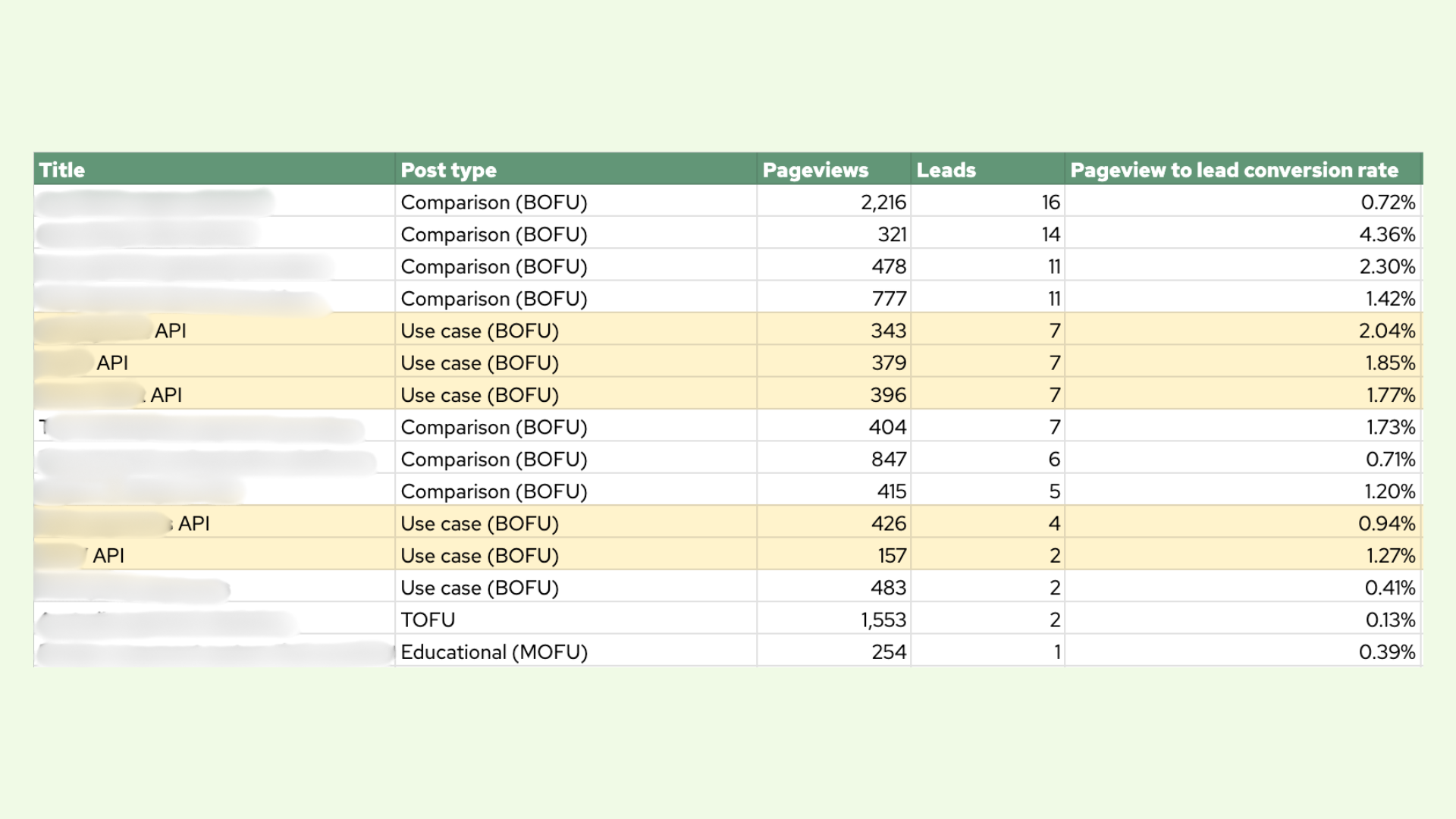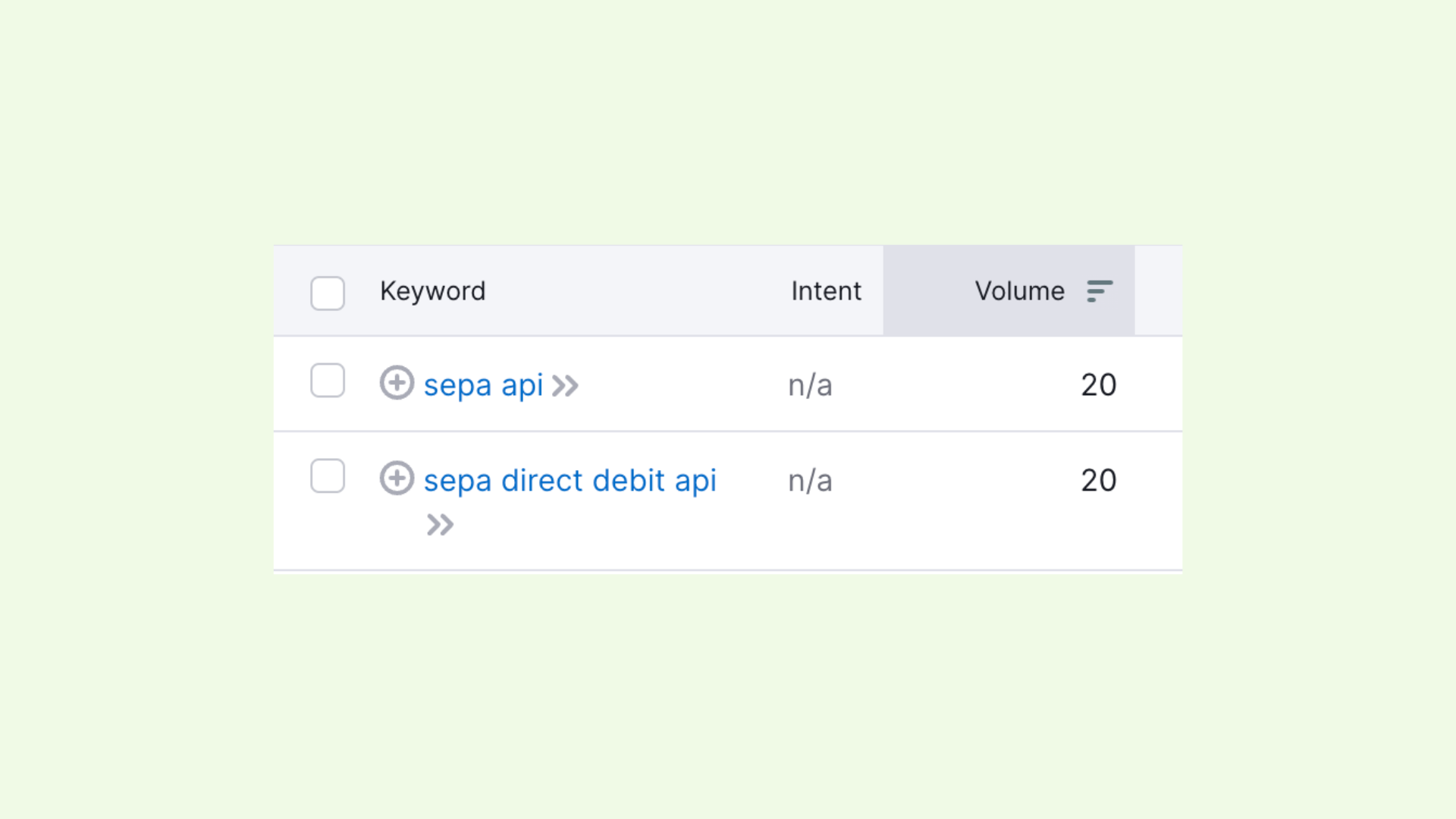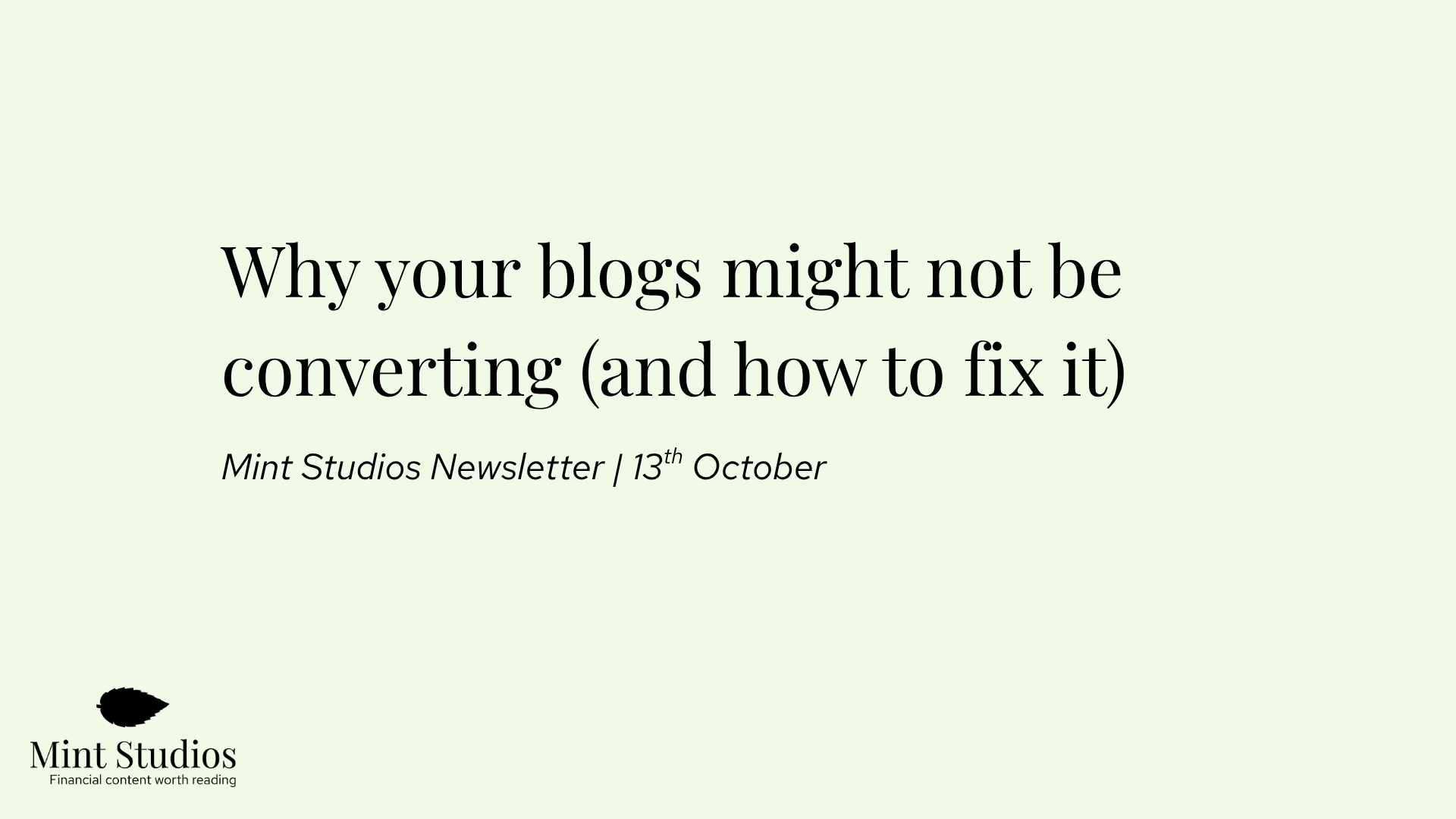After working with a few payment companies on their content marketing and SEO, we noticed an interesting trend: articles ranking for API keywords tend to bring in a high number of leads.
These are articles that rank for keywords like “SEPA API” or “direct debit API”. According to SEMRush, these keywords are only searched 20 - 30 times per month. And yet, based on our findings, these articles bring in some of the highest number of leads. .
We believe this happens for two key reasons:
- People searching this up are clearly lower down the buying funnel and more ready to buy, hence the high conversion rates.
- Few websites are targeting those keywords with good quality content, which makes it a lot easier to rank as well as stand out, hence faster results than usual.
In this article, we’ll look at why it’s worth targeting “API” keywords and the results we’ve seen, as well as how to target and rank for those keywords.
Note: join our newsletter to get updates every time we publish a new article!
Why target API keywords?
This all came about when we looked at the top 10 highest performing articles we wrote for our payment client, and noticed something interesting: 3 of them were targeting API keywords. When we look at the top 15 performing articles, 5 of them were targeting API keywords. We found that articles targeting API keywords made up 1 / 3 of the highest performing blogs.
Although they didn’t bring in the highest number of deals and revenue (unsurprisingly, comparison posts brought in the highest number and quality of deals measured by total revenue), they were the second highest performing type of content.

As you can see in the screenshot above, API focused keywords also had some of the highest conversion rates, with one of them bringing a conversion rate of above 2%!
Many marketers won’t target a keyword if the search volume is under 100 searches per month. In fact, if they only looked at the pageviews above, they’d probably see those results as a failure. And yet, because we can attribute the number of leads to individual articles, we know that articles targeting API keywords brought in a total of 27 leads that year.
Remember that for a payment company, a customer is often worth hundreds of thousands or even millions per year. If we take an average close rate of 20% (these are high quality new contacts, not gmail addresses), those articles brought in about 5 customers, which could equal well over $500k in annual value. And that’s not even including the leads brought in by all the other articles we produced. As you can see in the screenshot, our articles brought in a total of 102 leads – so the total value from content is well into the 7 figures.
Imagine the amount of business opportunity missed if we had just looked at traffic as a measure of success and not the actual number of leads. If we just looked at traffic, we would have assumed that API keywords were a waste of time and not worth pursuing. And yet, with the right tracking in place, we know that they are and it’s worth producing more of them.
Not only that: since few companies target API keywords, we were able to get to position 1 of Google in a matter of weeks or even days. And as we’ll see below, the content we wrote was a lot more advanced and technical than what was already ranking, which meant our content stood out a lot more and helped bring in even more conversions.
There are two reasons we think people don’t target API keywords:
Marketers at payment companies don’t believe their target market is searching API keywords
When we talk about “API” keywords to others in the industry, we often get push back because people don’t believe their target market is using these keywords to do research. They usually believe that only developers – who are operational users and therefore not the end buyer – would research this, and therefore it’s not worth targeting them. Payment companies are often targeting Heads of Payments, product managers and commercial directors, and may instead decide to target a higher volume keyword like “payment orchestration”.
But based on our experience, this isn’t true. More commercially minded people do in fact research API related words. We find that people generally use the word “API” to mean a transfer or connection between two programmes, even if an API isn’t a good solution for their specific use cases. It’s very believable that a commercially minded person is looking for an API for a specific payment method to better customize their payment flow or better organize their reporting or reconciliation.
Another belief people have is that the person doing research may only be interested in developer documentation. If we were targeting developers, then that would be true. But since we’re targeting commercially minded people, they are probably looking for more business type information, such as how to get set up with the API, the specific benefits of using theirs and how to evaluate a provider. As we’ll explain later, that’s what we include in the articles we write.
Wondering why your agency may not be suggesting these types of keywords? A lot of agencies, in our experience, search for keywords by inputting your competitors into an SEO tool. Although this is a good place to start (we also do this as part of our research), it doesn’t give you the whole picture. You’ll just end up targeting the same keywords as your competitors, and miss out on key opportunities – like API keywords.
The search volume is too low, so marketers don’t believe it’s worth ranking for
The second reason we believe few people target API keywords is because most people are still using keyword search volume and traffic as a measure of success. When people say search volume is low, it likely means that they’ve gone to Ahrefs or SEMRush and seen that the search volume is under 50 per month.

But there are a few reasons this line of reasoning doesn’t usually work:
1. SEMRush and Ahrefs are not the most accurate tools
Very often, SEMRush or Ahrefs tells us that a keyword is only searched 50 times per month – but when we do end up ranking for it, we often get hundreds of pageviews per month. We’ve written an entire article on this topic where we used the example of the Mint Studios website ranking first for the keyword “fintech newsletters” – which, according to SEMRush, only gets 70 searches per month – with this article: Top 18 Fintech Newsletters (That Include Deep Dives

But when we go into our own Mint Studios Google Analytics, we can see that we actually get 250 pageviews per month to that article, and quite a lot of conversions.
The problem is, if we had made a decision to target a keyword based on SEMRush’s numbers, (click through rate of 27% from Google, and conversion rate of 0.5% on 70 searches per month), we would have assumed we’d only get 0.01 conversions per month, or 1 conversion every 10 months.
However, that’s not what happened. Instead, we get 250 pageviews per month and between 10 to 17 conversions per month. That’s a conversion rate of 6.8%!
So to conclude: don’t take SEMRush or Ahrefs numbers as gospel, as they are often inaccurate and hide potential opportunities.
2. You want to prioritize keywords based on intent, not volume
If you work for a company selling a product or service, your priority is generating leads and acquiring customers. This is different to a publisher that monetizes via ads and therefore is aiming for as many pageviews as possible. In other words: since you’re selling a product, you should care about the quality of the people visiting your site, not how many.
Let’s continue on from the example above with “fintech newsletters”. We get a lot of conversions via this article because the keyword we’re targeting is action-driven. Someone typing up “fintech newsletters” is clearly looking to sign up to a newsletter. If our article on “fintech newsletters” was ranking for “productivity tips”, we probably wouldn’t get any conversions. And that’s why picking the right keyword with the right intent is so important.
What matters is conversion rate, not number of pageviews. Would you rather be ranking for a keyword with 50 searches a month and a 5% conversion rate? Or 500 searches a month and 0.01% conversion rate? As a company, you care about a high conversion rate, not the number of searches. Don’t apply advice for publishers, to advice for you, a company selling a product or service.
And that’s why you’re better off ranking for a highly targeted API keyword that has a conversion rate of 2.4% and a traffic of 300 pageviews, then a different keyword that brings in 1,500 pageviews and has a conversion rate of 0.1%.
You can go deeper into our thinking about this in this article: Low Volume, High ROI Keywords: Why You Should Include Them in Your Content Strategy
How to find and pick the right API keywords
When it comes to keyword research and picking the right keywords, we take the same approach we take when doing research for Bottom of the Funnel content: interview salespeople or people in the team who understand customer pain points.
This is very important. You cannot pick the right keywords without an intimate knowledge of your ideal customer, their pain points, how they compare you to competitors and even how they typically find you. We like to ask people on the team questions like:
- What was the last prospect/company that you had a really easy time closing? What type of prospects are the ones that are the easiest to close?
- What are you usually compared to? What are the alternatives?
- What is the most common reason for buying your product?
- How do they currently solve X and how much does it cost to do so?
- What happened last time their problem came up? What did they do?
- What are the pain points that you keep seeing?
- What are the most common use cases for using the product?
- What would you say is your biggest competitive advantage?
- Is it possible for prospects to solve their problems without X? How?
Based on those conversations, we can then pick out API keywords we think can work. Examples are:
- “SEPA API”
- “Bill payment API”
- “Reconciliation API”
- “Accounts payable API”
Think of specific use cases where people may want to use an API and your solution would be able to help them. Amazingly, this still works even if your company doesn’t have an API.
Here’s a specific example to illustrate this: we have a payment client that doesn’t have an API, mainly because an API doesn’t make sense for what they do. Their product requires the user to complete huge file transfers, and an API is simply a bad method of transferring huge files. Instead, they use an STPF connection to transfer files.
However, we still targeted an API keyword that described their use case. Because as we’ve said above, people use the phrase “API” as a general term for file transfer, without perhaps understanding that an API wouldn’t work well for that specific example. We targeted the keyword with an article that explains in detail why an API isn’t the best tool for this specific use case, and then explained how our client’s product does it better. This is also a good example of why it often makes more sense to target a keyword with a blog article, rather than a product page.
We call this specific strategy “damming demand”, and you can read more about it here: How to Create a New Fintech Category with Content by DAMming Demand
Once you have a list of keyword ideas, you can then use a tool like SEMRush to see which one has more searches to help you prioritize: you’re still better off targeting a very BOFU keyword with 30 searches rather than one with 10 searches per month. However, that doesn’t mean you should ignore the lower volume ones as they can also be very valuable.
How to write an “API” article that will rank highly and bring in conversions
Picking the right keyword to target is just half the battle. You also need to create a piece of content that will rank well, answer the searcher’s question and will convert the reader into a customer. There are a three ways you can target the keyword:
- Target the keyword with Google Ads and a landing page
- Target the keyword via SEO with a product / landing page
- Target the keyword via SEO with a piece of content
If resources are tight and you don’t have a strong writer to produce a piece of content, we’d recommend targeting API keywords with Google Ads first. It’s also a good way to test the keyword before committing more resources (we also do this with clients if we aren’t sure about a keyword).
Your second option is to target the keyword with a product page organically, without any ads. This can work well if there is very little competition for the keyword and you don’t have the resources to write a piece of content. However, you may struggle to rank.
In our experience, it’s easier to rank for a keyword with a blog article than a page. This is because there is more text in an article (which Google likes), and it’s also easier to go into more detail about what the searcher might be looking for, how your product works and to include graphics as well. However, if resources are tight, then you can start with a product page and see how you get on. Here are some examples of good product pages targeting an API keyword.
In an ideal world, you go for the third option: target the keyword with a blog article. This allows you to go more in-depth, giving you a better chance of ranking and answering the searcher’s questions.
But the challenge here is the writing itself. Finding someone who can write this type of content is hard, because it requires being able to write for a technical and commercially minded audience (which is why the “write for a 5 year old” advice doesn’t work here). It also needs to be written by someone who understands payments and who can write clearly.
We’ve written a big guide on writing about payments here, but ultimately it all comes down to finding a great writer: 8 Tips To Write Great Payments Content (From Writing 80+ Articles on Payments)
In terms of the structure and what type of information to include in your article, here are some examples of key sections and topics you can include:
- How does your API work?
- What are the key features and benefits customers get when using your API?
- When does it make sense to use an API vs another type of integration?
- Top use cases for your API
- What type of company is your API best for?
- Example of a customer using your API
- How to pick an API provider
The key thing to keep in mind is to put yourself in the customers’ shoes. You’re likely targeting someone who is doing extensive research, putting together a shortlist of providers and will eventually present them to the decision maker. Why are they looking for an API? What information do they want? What do they need to know about how you’re different from competitors? That’s the type of information to include in your article.
This is why we like to base our content on an interview with a product or salesperson, to make sure we get all the features and use cases right.
If you’re not sure what strong API content looks like, here are some public examples of API content we’ve written that have done well:
- Settlement API: How to master payment reconciliation with Zai
- SEPA API: How to embed euro payments with Modulr
- Direct Debit API: How to set one up (and when to use one)
- Real-time payments API: How to embed a solution with Modulr
Why should every payment company target API keywords? They’re easier to rank for and will bring in a high number of leads
Hopefully you understand why API keywords are a great opportunity to target as a payment company and why they should be part of your SEO and content strategy. As you’ve seen based on our work with our client, articles ranking for API keywords had some of the highest conversion rates and because of the low competition, we were able to rank and get results relatively quickly.
If resources are tight, you can start by targeting them with Google Ads or a product page. But if you can, a blog page will give you the most room to make a case for your API.











